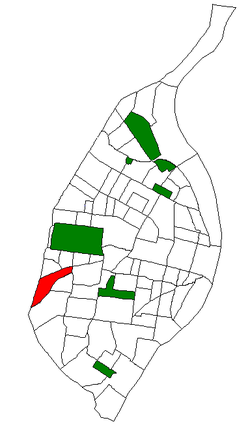Ellendale, St. Louis
| Ellendale | |
|---|---|
| St. Louis neighborhood | |
 Location of Ellendale within St. Louis |
|
| Country | United States |
| State | Missouri |
| City | St. Louis |
| Wards | 23, 24 |
| Area | |
| • Total | 0.83 sq mi (2.1 km2) |
| Population (2010) | |
| • Total | 1,575 |
| • Density | 1,900/sq mi (730/km2) |
| ZIP code(s) | Parts of 63139, 63143 |
| Area code(s) | 314 |
| Website | stlouis-mo.gov |
Ellendale is a neighborhood of St. Louis, Missouri. Its eastern portion is considered a part of Dogtown, which also includes four other neighborhoods north of Manchester.
Ellendale is bounded by Manchester on the North, I-44 on the south, Hampton on the East, and the City limits on the West. The neighborhood is surrounded by Lindenwood Park, Clifton Heights, The Hill, and the other "Dogtown" neighborhoods of Clayton/Tamm and Franz Park.
Originally, much of what is now Ellendale was land owned by James E. Sutton, who died in 1877. He bequeathed his land to his nine children. Kate Thomas, one of his daughters, started Ellendale. Although an accident destroyed much of the housing built before the World's Fair in 1904, some old homes built after the fair, mostly for the executives of Scullin Steel, are still standing. The area began to grow residentially in the last years of the century, helped along by the electric streetcars, which began running to the area in 1896.
The area was first opened to industrial activity in the 1850s because of the construction of the Pacific Railroad and the mining of clay for fire brick. Coal was also discovered, but not enough to make it a long-lasting, profitable endeavor. Scullin Steel Co. stood as a landmark in the neighborhood until it ceased production in the 1970s. The former site is now St. Louis Marketplace, located on Manchester and Abbott. The railroads still run through the area.
Originally, the River des Peres ran through the neighborhood, from its underground beginnings in Forest Park. It was converted to a drainage project, and now all that remains is the valley created by it. This valley forms the main topographical characteristic of the neighborhood.
...
Wikipedia
